中国古代四大发明中英文版
- 格式:ppt
- 大小:1.16 MB
- 文档页数:30
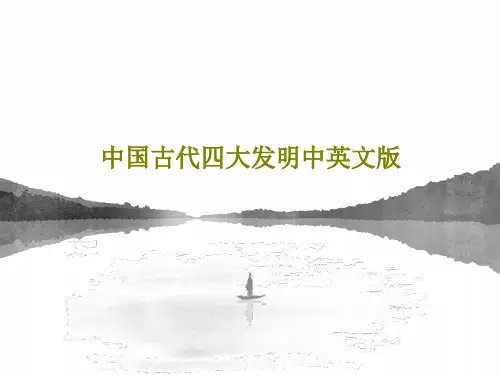
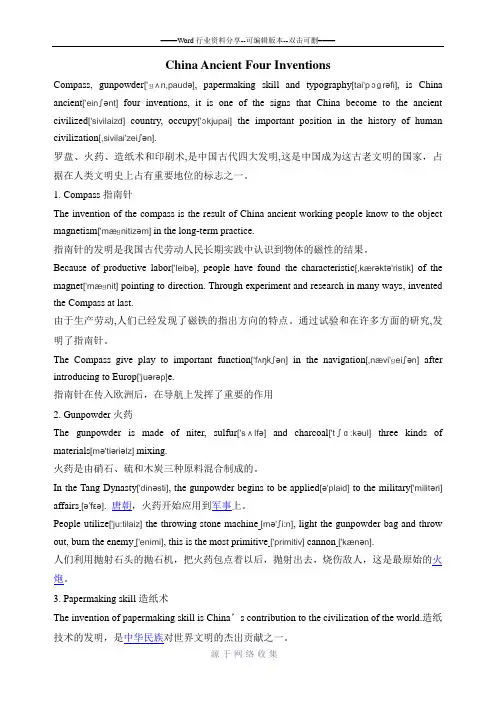
China Ancient Four InventionsCompass, gunpowder['ɡʌn,paudə], papermaking skill and typography[tai'pɔɡrəfi], is China ancient['einʃənt]four inventions, it is one of the signs that China become to the ancient civilized['sivilaizd]country, occupy['ɔkjupai]the important position in the history of human civilization[,sivilai'zeiʃən].罗盘、火药、造纸术和印刷术,是中国古代四大发明,这是中国成为这古老文明的国家,占据在人类文明史上占有重要地位的标志之一。
1. Compass指南针The invention of the compass is the result of China ancient working people know to the object magnetism['mæɡnitizəm] in the long-term practice.指南针的发明是我国古代劳动人民长期实践中认识到物体的磁性的结果。
Because of productive labor['leibə], people have found the characteristic[,kærəktə'ristik]of the magnet['mæɡnit] pointing to direction. Through experiment and research in many ways, invented the Compass at last.由于生产劳动,人们已经发现了磁铁的指出方向的特点。
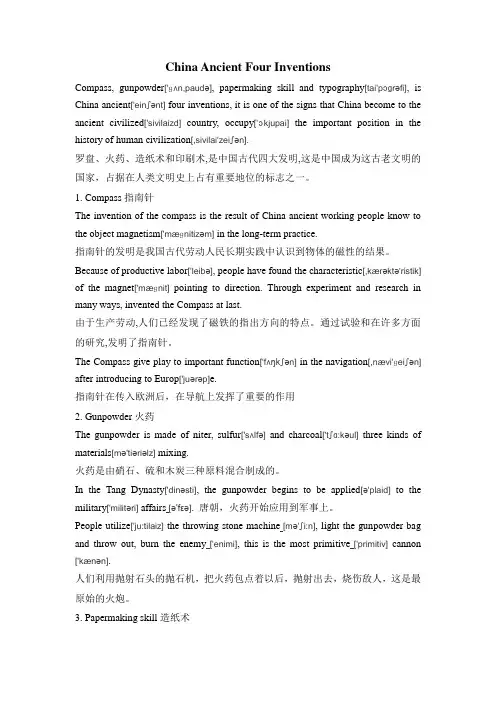
China Ancient Four InventionsCompass, gunpowder['ɡʌn,paudə], papermaking skill and typography[tai'pɔɡrəfi], is China ancient['einʃənt] four inventions, it is one of the signs that China become to the ancient civilized['sivilaizd]country, occupy['ɔkjupai]the important position in the history of human civilization[,sivilai'zeiʃən].罗盘、火药、造纸术和印刷术,是中国古代四大发明,这是中国成为这古老文明的国家,占据在人类文明史上占有重要地位的标志之一。
1. Compass指南针The invention of the compass is the result of China ancient working people know to the object magnetism['mæɡnitizəm] in the long-term practice.指南针的发明是我国古代劳动人民长期实践中认识到物体的磁性的结果。
Because of productive labor['leibə], people have found the characteristic[,kærəktə'ristik] of the magnet['mæɡnit]pointing to direction. Through experiment and research in many ways, invented the Compass at last.由于生产劳动,人们已经发现了磁铁的指出方向的特点。
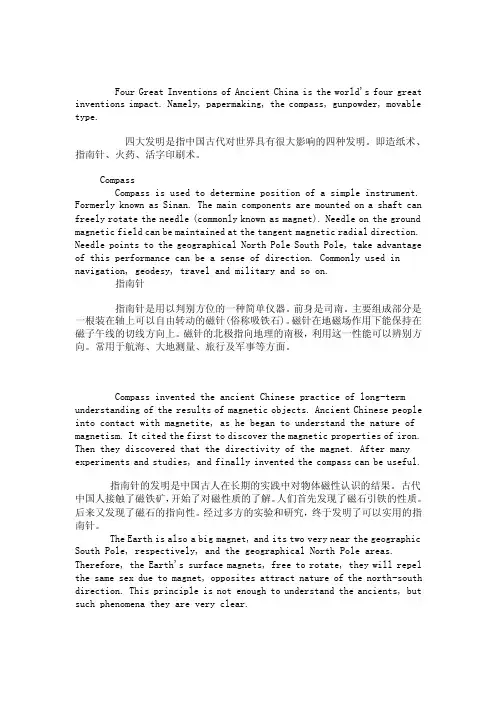
Four Great Inventions of Ancient China is the world's four great inventions impact. Namely, papermaking, the compass, gunpowder, movable type.四大发明是指中国古代对世界具有很大影响的四种发明。
即造纸术、指南针、火药、活字印刷术。
CompassCompass is used to determine position of a simple instrument. Formerly known as Sinan. The main components are mounted on a shaft can freely rotate the needle (commonly known as magnet). Needle on the ground magnetic field can be maintained at the tangent magnetic radial direction. Needle points to the geographical North Pole South Pole, take advantage of this performance can be a sense of direction. Commonly used in navigation, geodesy, travel and military and so on.指南针指南针是用以判别方位的一种简单仪器。
前身是司南。
主要组成部分是一根装在轴上可以自由转动的磁针(俗称吸铁石)。
磁针在地磁场作用下能保持在磁子午线的切线方向上。
磁针的北极指向地理的南极,利用这一性能可以辨别方向。
常用于航海、大地测量、旅行及军事等方面。
Compass invented the ancient Chinese practice of long-term understanding of the results of magnetic objects. Ancient Chinese people into contact with magnetite, as he began to understand the nature of magnetism. It cited the first to discover the magnetic properties of iron. Then they discovered that the directivity of the magnet. After many experiments and studies, and finally invented the compass can be useful.指南针的发明是中国古人在长期的实践中对物体磁性认识的结果。
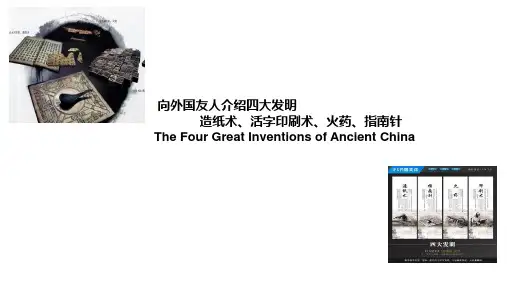
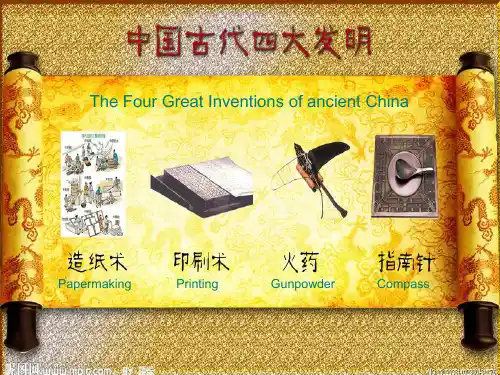
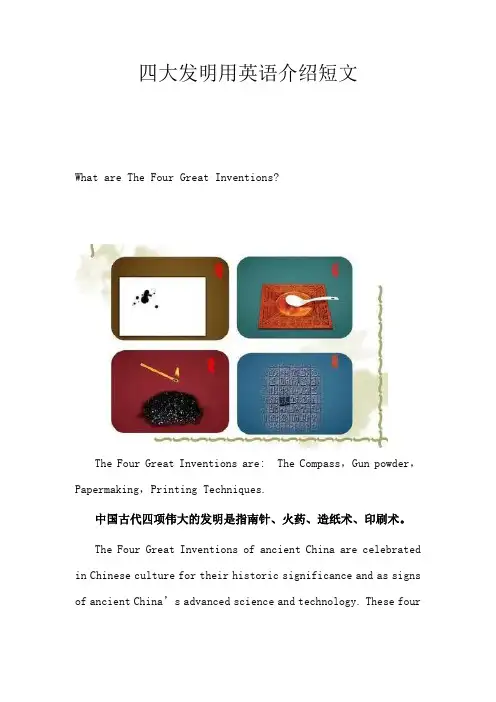
四大发明用英语介绍短文What are The Four Great Inventions?The Four Great Inventions are: The Compass,Gun powder,Papermaking,Printing Techniques.中国古代四项伟大的发明是指南针、火药、造纸术、印刷术。
The Four Great Inventions of ancient China are celebrated in Chinese culture for their historic significance and as signs of ancient China’s advanced science and technology. These fourinventions greatly promoted the development of China’s economy, politics, and culture.中国古代的四大发明因其历史意义和作为中国古代先进科学技术的标志而在中国文化中受到赞扬。
这四大发明大大促进了中国经济、政治和文化的发展。
The CompassThe history of the compass can be dated back tothe Warring States Period (476–221 BC), when Chinese people used a device calledsi nan to point the direction.指南针的历史可以追溯到战国时期(公元前476-221年),当时中国人使用一种叫做司南的装置来指明方向。
After constant improvement, a round compass with a tiny needle made of magnetized steel were invented during the early Song Dynasty. One end of the tiny needle points to the south and the other points to the north. The compass was then introduced to the Arab world and Europe during the Northern Song era (960–1127).经过不断的改进,在宋朝初期发明了一种带有磁化钢制成的小针的圆形罗盘。
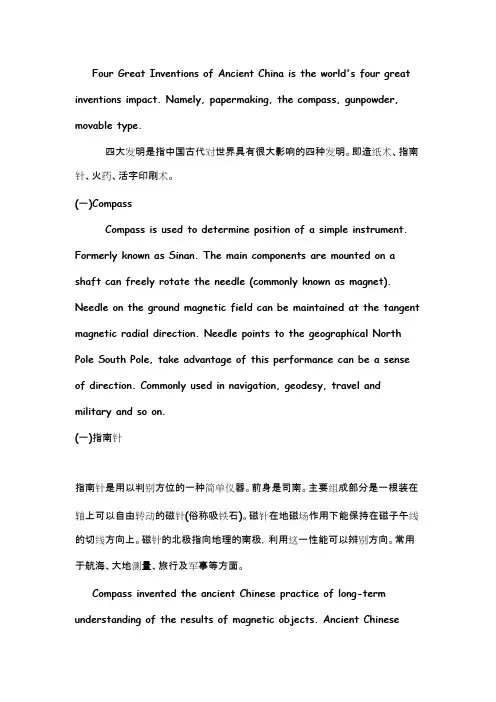
Four Great Inventions of Ancient China is the world's four great inventions impact. Namely, papermaking, the compass, gunpowder, movable type.四大发明是指中国古代对世界具有很大影响的四种发明。
即造纸术、指南针、火药、活字印刷术。
(一)CompassCompass is used to determine position of a simple instrument. Formerly known as Sinan. The main components are mounted on a shaft can freely rotate the needle (commonly known as magnet). Needle on the ground magnetic field can be maintained at the tangent magnetic radial direction. Needle points to the geographical North Pole South Pole, take advantage of this performance can be a sense of direction. Commonly used in navigation, geodesy, travel and military and so on.(一)指南针指南针是用以判别方位的一种简单仪器。
前身是司南。
主要组成部分是一根装在轴上可以自由转动的磁针(俗称吸铁石)。
磁针在地磁场作用下能保持在磁子午线的切线方向上。
磁针的北极指向地理的南极,利用这一性能可以辨别方向。
常用于航海、大地测量、旅行及军事等方面。
Compass invented the ancient Chinese practice of long-term understanding of the results of magnetic objects. Ancient Chinesepeople into contact with magnetite, as he began to understand the nature of magnetism. It cited the first to discover the magnetic properties of iron. Then they discovered that the directivity of the magnet. After many experiments and studies, and finally invented the compass can be useful.指南针的发明是中国古人在长期的实践中对物体磁性认识的结果。

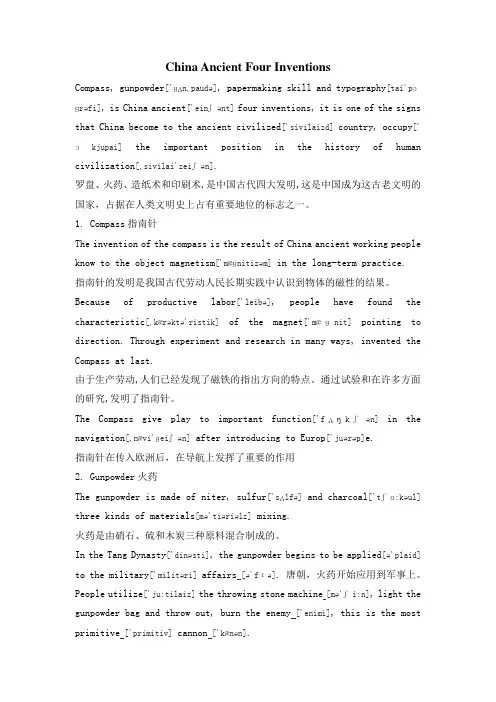
China Ancient Four InventionsCompass, gunpowder['ɡʌn,paudə], papermaking skill and typography[tai'pɔɡrəfi], is China ancient['einʃənt]four inventions, it is one of the signs that China become to the ancient civilized['sivilaizd] country, occupy['ɔkjupai]the important position in the history of human civilization[,sivilai'zeiʃən].罗盘、火药、造纸术和印刷术,是中国古代四大发明,这是中国成为这古老文明的国家,占据在人类文明史上占有重要地位的标志之一。
1. Compass指南针The invention of the compass is the result of China ancient working people know to the object magnetism['mæɡnitizəm] in the long-term practice.指南针的发明是我国古代劳动人民长期实践中认识到物体的磁性的结果。
Because of productive labor['leibə], people have found the characteristic[,kærəktə'ristik]of the magnet['mæɡnit]pointing to direction. Through experiment and research in many ways, invented the Compass at last.由于生产劳动,人们已经发现了磁铁的指出方向的特点。
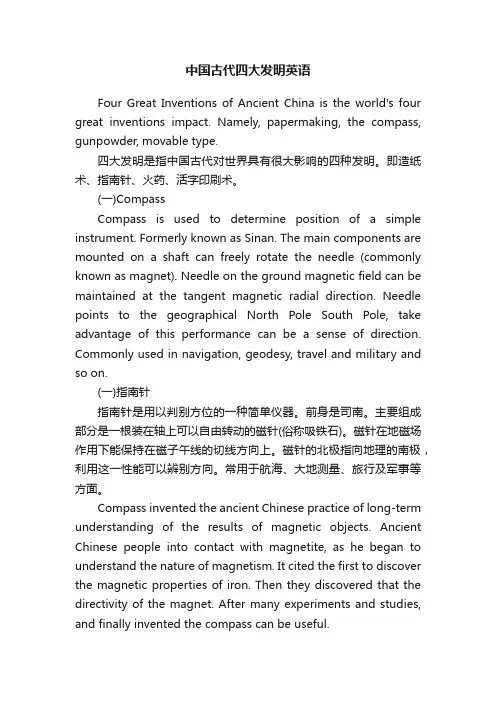
中国古代四大发明英语Four Great Inventions of Ancient China is the world's four great inventions impact. Namely, papermaking, the compass, gunpowder, movable type.四大发明是指中国古代对世界具有很大影响的四种发明。
即造纸术、指南针、火药、活字印刷术。
(一)CompassCompass is used to determine position of a simple instrument. Formerly known as Sinan. The main components are mounted on a shaft can freely rotate the needle (commonly known as magnet). Needle on the ground magnetic field can be maintained at the tangent magnetic radial direction. Needle points to the geographical North Pole South Pole, take advantage of this performance can be a sense of direction. Commonly used in navigation, geodesy, travel and military and so on.(一)指南针指南针是用以判别方位的一种简单仪器。
前身是司南。
主要组成部分是一根装在轴上可以自由转动的磁针(俗称吸铁石)。
磁针在地磁场作用下能保持在磁子午线的切线方向上。
磁针的北极指向地理的南极,利用这一性能可以辨别方向。
常用于航海、大地测量、旅行及军事等方面。
英文写作: 中华传统文化之四大发明一、请将下面这段话翻译成英文:中国的四大发明包括指南针、火药、造纸术和印刷术,它们是中国在人类文明史上占有重要地位的标志之一。
第一个指南针产生于战国时期(the Warring States Period),是利用天然磁石(natural magnet)来辨别方向的一种简单仪器。
火药发明于隋唐时期,主要应用于军事领域,造纸术于东汉年间由蔡伦改进,使纸成为人们普遍使用的书写材料。
印刷术,又称活字印刷术,大大促进了文化的传播。
四大发明对世界经济的发展和人类文化的进步做出了巨大的贡献。
【参考翻译】Four great inventions of China include the compass, gun powder, the paper-making technique and the printing technique. They are one of the marks that China occupies an important position in the history of human civilization.The first compass was invented during the Warring States Period. It was a simple device employing natural magnets to identify directions. Gunpowder was invented in Sui and Tang Dynasties and was mainly used in military areas. The paper-making technique was developed by Cai Lun in the Eastern Han Dynasty, making paper a commonly used writing material. The Printing technique, also called movable type printing, promoted the spread of culture significantly. Thefour great inventions of China made tremendous contribution to the development of the world's economy and the progress of the culture of mankind.二、翻译:四大发明六级练习题(2013年12月卷四)中国以引进新的方式方法来改变人类的生活而著称。
值得收藏!用英语介绍中国四大发明,中国四大发明用英语怎么说?我们都知道中国有四大发明,分别是“火药”、“指南针”、“造纸术”和“印刷术”,这四大发明是我们的骄傲;我们跟外国的朋友介绍的时候会经常提到,那么四大发明用英文该怎么表达呢?火药 Gunpowder简介一种黑色或棕色的炸药,由硝酸钾、木炭和硫磺机械混合而成,最初均制成粉末状,以后一般制成大小不同的颗粒状,可供不同用途之需,在采用无烟火药以前,一直用作唯一的军用发射药指南针 Compass简介指南针是一种判别方位的简单仪器,又称指北针。
指南针的前身是中国古代四大发明之一的司南。
主要组成部分是一根装在轴上可以自由转动的磁针,磁针在地磁场作用下能保持在磁子午线的切线方向上,磁针的北极指向地理的北极,利用这一性能可以辨别方向。
常用于航海、大地测量、旅行及军事等方面。
造纸术 Papermaking technique简介造纸术是中国四大发明之一,人类文明史上的一项杰出的发明创造。
中国是世界上最早养蚕织丝的国家。
汉族劳动人民以上等蚕茧抽丝织绸,剩下的恶茧、病茧等则用漂絮法制取丝绵。
漂絮完毕,篾席上会遗留一些残絮。
当漂絮的次数多了,篾席上的残絮便积成一层纤维薄片,经晾干之后剥离下来,可用于书写。
这种漂絮的副产物数量不多,在古书上称它为赫蹏或方絮。
这表明了中国汉族造纸术的起源同丝絮有着渊源关系。
活字印刷术 Movable type printing简介活字印刷术是一种古代印刷方法。
是中国古代汉族劳动人民经过长期实践和研究才发明的。
先制成单字的阳文反文字模,然后按照稿件把单字挑选出来,排列在字盘内,涂墨印刷,印完后再将字模拆出,留待下次排印时再次使用。
活字印刷术的发明是印刷史上一次伟大的技术革命。
北宋庆历间(1041-1048)中国的毕升(约970年—1051年)发明的泥活字标志活字印刷术的诞生。
他是世界上第一个发明人,比德国J.谷登堡活字印术早约400年。
四大发明讲解词范文(中英文版)Section 1: IntroductionHello everyone, today I"m going to talk about the Four Great Inventions of ancient China.These inventions have had a significant impact on the world and are still influential today.大家好,今天我要讲的是中国古代的四大发明。
这些发明对世界产生了重大影响,至今仍在发挥其作用。
Section 2: PapermakingThe first great invention is papermaking.Before papermaking was invented in China during the Eastern Han Dynasty, people used materials like bamboo strips and silk to record information.These materials were expensive and not very practical.第一种是造纸术。
在东汉时期中国发明造纸术之前,人们使用像竹片和丝绸这样的材料来记录信息。
这些材料既昂贵又不实用。
Section 3: PrintingThe second great invention is printing.The movable type printing invented by Bi Sheng during the Song Dynasty revolutionized the way information was disseminated.This innovation made it possible to produce books on a large scale, which in turn facilitated the spread of knowledge and ideas.第二种是印刷术。
中国古代四大发明英文版搜集整理人:邓顺雨The Four Great Inventions are :The Compass, Gun powder, Papermaking, and Printing.The compass[pitiful:The western people use the compass to point the direction, while ancient Chinese used it to predict the fates.]A compass is an instrument containing a freely suspended magnetic element which displays theThe magnetic compass is an made in China during the Qin dynasty (221-206 B.C.). (a mineral composed of an ironEventually someone noticed that the lodestones were better at pointing out real directions, leading to the first compasses. They designed the compass on a square slab which had markings for the cardinal points and the constellations. The pointing needle was a lodestone spoon-shaped device, with a handle that would always point south.Magnetized NeedlesMagnetized needles used as direction pointers instead of the spoon-shaped lodestones appeared in the 8th century AD, again in China, and between 850 and 1050 they seem to have become common as navigational devices on ships.Compass as a Navigational AidThe first person recorded to have used the compass as a navigational aid was Zheng He (1371-1435), from the Y unnan province in China, who made seven ocean voyages between 1405 and 1433.The Gunpowder[ Pitiful: The western people used the gunpowder to produce the weapons, while ancient Chinese used it to make fireworks.]Chinese taoist alchemists were the major force behind the early invention of gunpowder. Emperor Wu Di (156-87 B.C.) of the Han dynasty financed research done by the alchemists on the secrets of eternal life. The alchemists experimented with the sulphur and saltpeter heating the substances in order to transform them. The alchemist Wei Boyang wrote the Book of the Kinship of the Three detailing the experiments made by the alchemists.During the 8th century T ang dynasty, sulphur and saltpeter were first combined with charcoal to create an explosive called huoyao or gunpowder. A substance that did not encourage eternal life, however, gunpowder was used to treat skin diseases and as a fumigant to kill insects before its advantage as a weapon was made clear.The Chinese began experimenting with the gunpowder filled tubes. At some point, they attached bamboo tubes to arrows and launched them with bows. Soon they discovered that these gunpowder tubes could launch themselves just by the power produced from the escaping gas. The true rocket was born.The papermakingThe word paper is derived from the name of the reedy plant papyrus, which grows abundantly along the Nile River in Egypt. However, true paper is made of pulped cellulose fibers like wood, cotton or flax.First There Was PapyrusPapyrus is made from the sliced sections of the flower stem of the papyrus plant, pressed together and dried, and then used from writing or drawing. Papyrus appeared in Egypt around 2400 B.C.Then There Was PaperA courtier named Ts'ai-Lun, from Lei-yang in China, was the first recorded inventor of paper circa 105 A.D. Ts'ai-Lun presented paper and a papermaking process to the Chinese Emperor and that was noted in the imperial court records. There may have been papermaking in China earlier than the above date, but inventor Ts'ai-Lun did much for the spread of papermaking technology in China.Chinese PapermakingThe ancient Chinese first made paper in the following fashion.∙Plant fibers such as hemp were soaked and beaten into a sludge∙The sludge was strained through a cloth sieve attached to a frame that also served as a drying platform for the resulting paperNewsprintCharles Fenerty of Halifax made the first paper from wood pulp (newsprint) in 1838. Charles Fenerty was helping a local paper mill maintain an adequate supply of rags to make paper, when he succeeded in making paper from wood pulp. He neglected to patent his invention and others did patent papermaking processes based on wood fiber.Corrugated Papermaking - CardboardIn 1856, Englishmen, Healey and Allen, received a patent for the first corrugated or pleated paper. The paper was used to line men's tall hats.American, Robert Gair promptly invented the corrugated cardboard box in 1870. These were pre-cut flat pieces manufactured in bulk that opened up and folded into boxes.On December 20, 1871, Albert Jones of New York NY, patented a stronger corrugated paper (cardboard) used as a shipping material for bottles and glass lanterns.In 1874, G. Smyth built the first single sided corrugated board-making machine. Also in 1874, Oliver Long improved upon the Jones patent and invented a lined corrugated cardboard.Paper BagsThe first recorded historical reference to grocery paper bags was made in 1630. The use of paper sacks only really started to take off during the Industrial Revolution: between 1700 and 1800.Margaret Knight (1838-1914) was an employee in a paper bag factory when she invented a new machine part to make square bottoms for paper bags. Paper bags had been more like envelopes before. Knight can be considered the mother of the grocery bag, she founded the Eastern Paper Bag Company in 1870.On February 20, 1872, Luther Crowell also patented a machine that manufactured paper bags.Paper PlatesPaper foodservice disposables products were first made at the beginning of the 20th century. The paper plate was the first single-use foodservice product invented in 1904.Dixie CupsHugh Moore was an inventor who owned a paper cup factory, located next door to the Dixie Doll Company. The word Dixie was printed on the doll company's front door. Moore saw the word everyday, which reminded him of "dixies," the ten dollar bank notes from a New Orleans' bank that had the French word "dix' printed on the face of the bill. The bank had a great reputation in the early 1800s. Moore decided that "dixies" was a great name. After getting permission from his neighbor to use the name, he renamed his paper cups "Dixie Cups". It should be mentioned that Moore's paper cups first invented in 1908 were originally called health cups and replaced the single repeat-use metal cup that had been used with water fountains.The printingThe Chinese invention of Woodblock Printing, at some point before the first dated book in 868(the Diamond Sutra)金刚经, produced the world's first print culture. However, it is suspected in western world that book printing may have occurred long before this date.。
中国古代四大发明thefourgreatinventionsofancientCh中国古代四大发明 the four great inventions of ancient China 火药gunpowder 印刷术printing 造纸术paper-making指南针the compass 书法calligraphy文房四宝(笔墨纸砚):The Four Treasure of the Study(Brush, Ink-stick, Paper, and Ink-stone)京剧Peking opera 秦腔Qin opera 相声comic cross talk杂技acrobatics 踩高跷stilt walk 木偶戏puppet show皮影戏shadowplay 折子戏opera highlight 泥人 clay figure口技ventriloquism 花灯festival lantern 灯谜lantern riddle刺绣embroidery 剪纸paper cutting 针灸acupuncture中国画 traditional Chinese painting水墨画 Chinese brush painting中国结 Chinese knot小吃摊snack bar/snack stand 月饼 moon cake年糕 rice cake 油条 deep-fried dough sticks豆浆 soybean milk 馒头 steamed buns花卷 steamed twisted rolls 包子 steamed stuffed buns拉面hand-stretched noodles 馄饨wonton (dumplings in soup)豆腐 tofu; bean curd 麻花 fried dough twist蛋炒饭 fried rice with egg春节:the Spring Festival 元宵节:the Lantern Festival清明节:the Tomb-sweeping Day 端午节:the Dragon-boat Festival中秋节:the Mid-autumn Day 重阳节:the Double-ninth Day 七夕节:the Double-seventh Day大学》The Great Learning 《中庸》The Doctrine of the Mean 《论语》The Analects of Confucius 《孟子》The Mencius《孙子兵法》The Art of War 《三国演义》Three Kingdoms《西游记》Journey to the West 《红楼梦》Dream of the Red Mansions 《水浒传》Heroes of the Marshes《山海经》The Classic of Mountains and Rivers《资治通鉴》History as a Mirror 《春秋》The Spring and Autumn Annals 《史记》Historical Records 《诗经》The Book of Songs《易经》The Book of Changes 《礼记》The Book of Rites《三字经》Three-character Scriptures秦始皇陵 the Mausoleum of Emperor Qinshihuang兵马俑 T erracotta Warriors and Horses 大雁塔 Big Wild Goose Pagoda 丝绸之路the Silk Road 敦煌莫高窟Mogao Grottoes 华清池 Huaqing Hot Springs 五台山Wutai Mountain九华山 Jiuhua Mountain 蛾眉山Mount Emei泰山 Mount Tai 黄山 Mount Huangshan; the Yellow Mountain 故宫 the Imperial Palace 天坛 the Temple of Heaven苏州园林 Suzhou gardens 西湖 West Lake九寨沟 Jiuzhaigou Valley 日月潭 Sun Moon Lake布达拉宫Potala Palace。